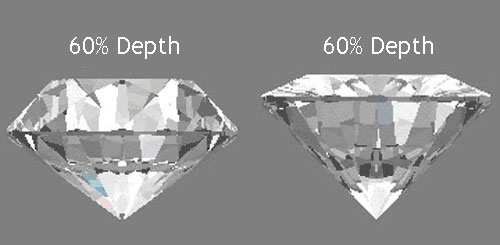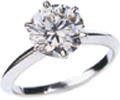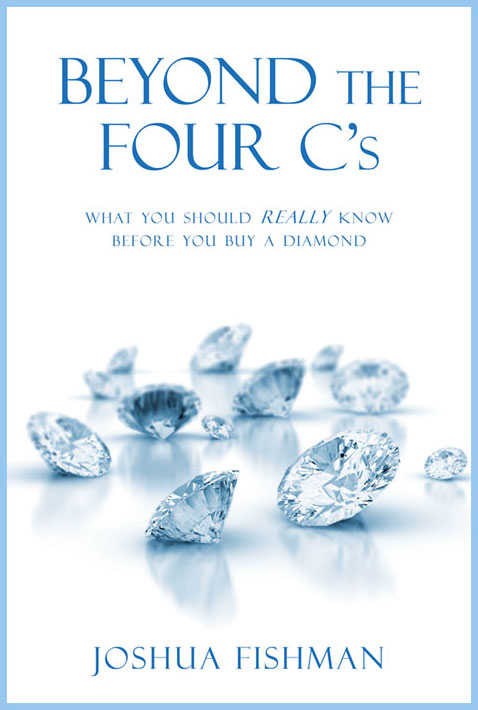Loose Diamonds
Diamond Guides
- The 4 C's and More
- Diamond Shape
- Diamond Cut
- Diamond Color
- Diamond Clarity
- Diamond Carat Size
- GIA Certification
- GIA Cut Grades
Jewelry Guides
- Engagement Ring Guide
- Diamond Tips
- Caring For Your Jewelry
- Tips on Getting Her Ring Size
- How To Build Your Fine Diamond Jewelry Wardrobe
- Diamond & Jewelry Appraisals
- Branded Diamonds
Education Videos
Design Your Engagement Ring
A. Fishman Difference
- Direct Diamond Prices
- Loose Diamond Manufacturer
- A+ Rating From BBB
- Customer Testimonials
- 100% Money Back Guarantee
- FREE FedEx Overnight Shipping
- Lifetime Warranty
- 2% Discount for Bank Wires
- Why No "Shopping Cart"
Expert Guidance
- Expert Guidance
- 212-869-0085
While most diamond buyers focus on the The 4 C's to evaluate their diamond purchase, we at A. Fishman & Son feel very strongly that an exclusive focus on The 4 C's may lead you astray in evaluating whether the diamond you are considering is really a pretty diamond and worth the money you are about to spend. See What Makes a Diamond Pretty?
To take identically graded diamonds and just compare their certificates and prices is a sure fire way to make a mistake. What are the factors that you should consider and how do they impact the value of a diamond? See Diamond Advice - Two Identical Diamonds - But with Different Prices?
Let's discuss them. In the end, we hope you will come to the conclusion that you should be buying your diamonds from A. Fishman & Son, where your best interests are our primary concern. We welcome your call 212-869-0085 to discuss any of the matters described below:
Diamond Buying Philosophy
There are two basic philosophies in diamond buying and selling. There are diamond suppliers who look for diamonds which they can sell "cheap" and which have what appears to be statistically good certificates. In reality, these suppliers look for diamonds with a weak VS1 or SI1, or a low G color, or a weak cut, which they can sell at a price which appears low relative to other diamonds of the same grade. On the certificate, the diamonds appear to be the same and you might think that the less expensive one is a better deal. In many cases, our experience shows that this is not the case and that there is a good reason for the price difference.
The second philosophy, and the one which we at A. Fishman & Son adhere to, is just the opposite. Our goal is to provide our customer with the best looking diamond, and the best value, we can. That is in our customer's best interest, since you are buying a diamond, not a piece of paper, and it is in our best interest since your beautiful diamond is our best advertisement. The diamond has to "speak" to us, in terms of its brilliance and beauty. The clarity of the diamond has to be appealing, whether it is a VS or an SI quality. We want the diamond to be the kind we would recommend to our own family, regardless of the price of the diamond, whether expensive or less so.
In following this second philosophy, which we consider preferable, you have to really understand diamonds. Some of the important factors we take into account, and which you should be considering, are discussed below.
Factors Relating to Color, Clarity and Cut
Many buyers of diamonds today are fixated on the details of the Certificate. But that is like looking at the trees in the forest instead of the forest itself. What such a buyer is missing is the beauty, or lack of beauty, of the diamond in its entirety. Let's evaluate the individual elements of the Certificate.
Choice of Gemological Laboratories
Two diamonds of the same color, clarity, weight, depth and table percentages with a diamond certificate from one laboratory may appear to be the same as another diamond with the same description from another laboratory. And then you look at the price and see that one is much more expensive than the other.
In our experience, we have found that some labs other than the GIA (like the European Gemological Laboratory (EGL), International Gemological Institute (IGI) and American Gem Society (AGS) have a tendency to inflate their grades by 1 to 2 colors and 1 to 2 clarities. What is the result of this grade inflation? The result is that the diamond from the other lab is really a lower quality diamond than the GIA graded diamond. It only appears to be a lower priced diamond. In fact, it may be quite expensive for its true quality. Watch this video to see a scary example I just faced.
This is why we at A. Fishman & Son have a 100% GIA certified inventory!
More on Clarity Grade
Apart from the issue of whether the gemological laboratory is grading strictly enough, the type of inclusion in a diamond is crucial in evaluating the true value and desirability of that diamond. While there is not much difference between two VVS diamonds (except as discussed above under our discussion of laboratories), when you get to VS and SI grades, there can be a big difference between a desirable diamond and an undesirable one. Is the inclusion black, or white? Is it on the side of the diamond or in the center? Does it reflect around the diamond or is it visible only from the bottom of the diamond? And so on. While two diamonds of the same grade may both be accurately graded, there may a big difference in their desirability and, accordingly, their cost and value.
Furthermore, while it may not seem logical, a lower graded diamond (like an SI1 with some small white inclusions around the edge of the diamond) may be more desirable than a higher graded diamond (like a VS2 with a black inclusion in the center). The VS2 will cost more in todays market, but the SI1 will be the more desirable diamond. Only someone who truly understands diamonds and value can guide you to the "best" (the most desirable) diamond. (back to top)
Measurements
Rounds - A round diamond should be round. That seems simple enough. But no round diamond is perfectly round. There is always a deviation in roundness. But, how large a deviation in the diameter measurements of a round diamond is acceptable? In our opinion, any deviation more than .10mm is unacceptable (for example 6.50-6.60 is good; 6.40-6.55 is not). A number of years ago, the GIA used to give two depth percentages to round diamonds where the deviation in the roundness of the diamond exceeded .10mm. They used to call those certificates "double depth" certificates. Today, this is not the case and only one depth percentage is given. Nevertheless, a diamond more than .10mm "out of round" is not desirable and reduces the value of the diamond.
In addition to the roundness of the diamond, the overall look of the diamond should look like the weight it is supposed to be. You can find for example, 1 carat round diamonds whose depth and table percentages fit the theoretical "ideal" proportions, but that diamond only measures 6.1 or 6.2 mm in diameter. This is not an "ideal" cut diamond. It is a heavy cut diamond that looks the size of an .80-.85carat well cut diamond. It will sell for a lower price because it is less desirable as a diamond!
Here is a real example of what I refer to. Both of these diamonds are 1 carat diamonds, but one is poorly cut. This photo is of an actual diamond sent in to me by a customer who was going to buy the diamond on the right. I compared it to my diamond on the left and told the customer that, while he didn't have to buy my diamond, he should definitely not buy the other diamond. I am sure you would agree!
example of what I refer to. Both of these diamonds are 1 carat diamonds, but one is poorly cut. This photo is of an actual diamond sent in to me by a customer who was going to buy the diamond on the right. I compared it to my diamond on the left and told the customer that, while he didn't have to buy my diamond, he should definitely not buy the other diamond. I am sure you would agree!
Fancy Cuts - Many diamond sources describe the ideal proportions of fancy cut by saying, for example, that a marquise diamond should have a 2 to 1 length to width ratio. However, there is a big difference between a 1 carat marquise that measures 8x4, and one which measures 10x5. Both can weigh 1 carat, but only one (10x5 naturally) is worth buying. And, even if the diamond measures 10x5, that doesn't' mean it is cut properly and has the proper brilliance which it should. The same applies to other shapes. For example, just because a pear shape or oval diamond measures the appropriate length and width, doesn't tell you what the shape of the diamond really is. It may be squarish at the shoulders of the diamond instead of roundish. You want to know what the shape really is, not just the numbers and the ratios. (back to top)
Proportions
 Depth and Table Percentages - The idea that you can judge the brilliance and fire of a diamond just by looking at the depth and table percentages on the Certificate has gotten a lot of attention, especially with discussions of "ideal" or "Tolkowsky" cuts, or AGS "0" cuts. Nothing can be farther from the truth. It is not percentages, but the angles of the diamond which give any diamond the brilliance and fire which make it a thing of beauty. Two diamonds with the same depth percentage may look very different because the allocation of the depth of the stone is different. The total number is the same, but there is a big difference if the pavilion (bottom) of the diamond is deep, or if the crown (top) is high. In the same vein, the idea that a depth percentage of 62-63 (in round diamonds) with a small table (53-56) is a pretty diamond is just more of the same. A diamond like this, which is called "ideal", is usually smaller looking and may look dark in the center because of the absence of light. And, as mentioned above, this diamond may not have the diameter, and look, that the diamond of that weight should have.
Depth and Table Percentages - The idea that you can judge the brilliance and fire of a diamond just by looking at the depth and table percentages on the Certificate has gotten a lot of attention, especially with discussions of "ideal" or "Tolkowsky" cuts, or AGS "0" cuts. Nothing can be farther from the truth. It is not percentages, but the angles of the diamond which give any diamond the brilliance and fire which make it a thing of beauty. Two diamonds with the same depth percentage may look very different because the allocation of the depth of the stone is different. The total number is the same, but there is a big difference if the pavilion (bottom) of the diamond is deep, or if the crown (top) is high. In the same vein, the idea that a depth percentage of 62-63 (in round diamonds) with a small table (53-56) is a pretty diamond is just more of the same. A diamond like this, which is called "ideal", is usually smaller looking and may look dark in the center because of the absence of light. And, as mentioned above, this diamond may not have the diameter, and look, that the diamond of that weight should have.
There is much, much more that can be discussed. For example, in princess cut diamonds, the manner in which the diamond facets are cut is crucial to the brilliance and beauty of the diamond. Are the facets bunched in the middle or are they evenly spread out? Factors such as these are more important than whether the depth percentage is above or below a certain number.
Polish and Symmetry - Does it matter whether polish and symmetry on a Certificate reads "good", "very good" or "excellent"? Many diamond suppliers price their diamonds higher if the Certificate reads "very good" or "excellent" even though those grades do not guarantee you a pretty diamond! It is obvious that a diamond may be perfectly symmetrical and not be pretty and have brilliance and fire. A grade of "good" with the proper proportions is more important. And proportion is a question of how the construction of the diamond fits together as a whole, not their individual elements. If the diamond is cut to the proper angles, and if the diamond has the proper diameter, and if the diamond is cut with the proper facet arrangements, then you may have a good looking diamond. (back to top)
Fluorescence
Fluorescence in a diamond is not necessarily a positive or a negative. It depends. A diamond where the fluorescence makes the diamond look hazy or cloudy is a big negative in the diamond. On the other hand, you can have a diamond with no fluorescence which is cloudy or hazy and that is not a desirable diamond either. You need a trustworthy diamond supplier who will be able to describe the diamond to you accurately in order to evaluate it properly.
Another factor relating to fluorescence relates to the Color grade on the certificate. While fluorescence is supposed to be just a characteristic of the diamond which does not affect the Color grade, in practice it often does. I have seen many labs grade the Color grade of a diamond higher than its true color from the back of the diamond if it has fluorescence. Even the GIA! What is the consequence of this? If the diamond is priced based on the Certificate Color grade, then the price is really too high for the diamond itself, even if it appears to be an inexpensive price for the grade.
For more information on the GIA's view of fluorescence and its impact on diamonds please read A Contribution to Understanding the Effect of Blue Fluorescence on the Appearance of Diamonds. (Gems and Gemology, Winter 1997) (back to top)
Other Factors
There are many other factors which time, space and attention span do not permit me to go into here. The bottom line is that you need to rely on a professional diamond expert to guide you in making the right decision for your best interests. Someone who has the diamonds he is offering you in front of him and can take that diamond out and look at it for you and be honest in his description of it. That is what we at A. Fishman & Son do. Call us and speak to us about any issue you may have. We will be happy to guide you as we have many other customers.
Loose Diamonds
Shapes of Diamonds
Diamond Videos-New
About our Loose Diamonds
Perfect Diamonds
Pretty Diamonds
Round Cut
Princess Cut
Cushion Cut
Radiant Cut
Emerald Cut
Asscher Cut
Pear Shape
Oval Shape
Marquise Shape
Heart Shape
Diamond Jewelry
Brooches
Bracelets
Earrings
Engagement
Necklaces and Pendants
Wedding Rings
Custom Designed Jewelry
Diamond Guides
Diamond Guide - The 4 C's
Ethics of Lab-Grown Diamonds
Purchase: Beyond the Four C's
Diamond Guide Videos
Engagement Ring Guide
Understanding GIA Certificates
Understanding GIA Cut Grades
Pretty Diamonds
Diamond Clarity Enhancements
Conflict Free Diamonds
Identifying Fake Diamonds
Diamond Tips
Diamond Jewelry Appraisals
Diamond & Jewelry Care
Gift Giving
Beyond the 4 C's
Jewelry and Diamonds to Wear for a Lifetime - Not Just a Season!™
 A. Fishman & Son • 580 Fifth Avenue, Ste 402 • New York, NY 10036 • 212-869-0085
A. Fishman & Son • 580 Fifth Avenue, Ste 402 • New York, NY 10036 • 212-869-0085
Copyright © 2011-2022 A.Fishman & Son. All Rights Reserved. Website by YLWConsulting





